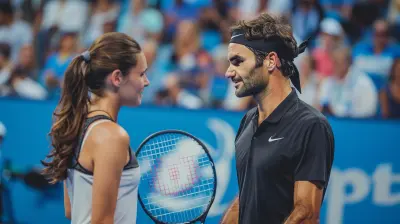Formula 1’s Iconic Rivalries: Senna vs. Prost
29 July 2025
Fasten your seatbelts, folks, because we’re heading full throttle into one of the most dramatic, nail-biting, and downright spicy rivalries in Formula 1 history: Ayrton Senna vs. Alain Prost. This wasn't just two dudes racing cars — oh no — this was gladiator-level drama on four wheels. You’ve got speed, politics, rain-soaked tracks, and enough passive-aggressive press conferences to power a reality show.
So kick back, maybe grab a snack (you’ll need the fuel), and let’s dive into the story of two men who turned the racetrack into a soap opera — in the best way possible.![]()
Meet The Legends: Who Were These Guys, Anyway?
Ayrton Senna: The Rain Master with the Soul of a Poet
Senna wasn’t just fast — he was otherworldly. You know that video game friend who always laps you on Rainbow Road while eating pizza with one hand? That was Senna… in real life. The Brazilian superstar had some kind of sixth sense when it came to squeezing performance out of a car, especially in wet conditions. It was like he could speak fluent “car.”But beyond the helmet, Senna was deeply spiritual, emotional, and fiercely competitive — the kind of guy who’d cry on the podium and then roast you in qualifying the next weekend. He lived and breathed motorsport. And yeah, he didn’t come to make friends. He came to win.
Alain Prost: The Professor with Ice in His Veins
Then you have Alain Prost — the complete opposite of Senna in almost every possible way. While Senna raced like his hair was on fire, Prost drove like he was cracking a math equation: calm, collected, and consistently brilliant.Dubbed “The Professor,” Prost didn’t rely on risky overtakes or flying lap heroics. He played the long game — reading the race, calculating every move, and executing it with surgical precision. It's like comparing a jazz solo to a symphony performance. Both beautiful, both brilliant — just totally different vibes.
And when these two collided (sometimes literally)? Oh boy… sparks flew.![]()
The Rivalry Hits The Grid: Honda, McLaren & The 1988 Firestarter
Teammates-to-Rivals: Sounds Like a Netflix Show, Right?
In 1988, McLaren decided to build a superteam by putting both Senna and Prost in the same car — a decision that aged about as well as milk in the sun.On paper, it was genius. McLaren had the best car, and now it had arguably the two best drivers. But let’s be real — asking Senna and Prost to play nice was like trying to host a dinner party with a lion and a gazelle. It was never going to be chill.
Still, they dominated the grid. Between them, they won 15 out of 16 races that year. The only race they didn’t win? It was because they were too busy battling each other to even notice someone else snuck through. Classic.
1989: The Year Things Got Messy
By the next season, whatever “respect” they had had officially packed its bags and left the building.The real chaos hit at the infamous Japanese Grand Prix in Suzuka. Here’s the SparkNotes version: Senna needed to win to stay in the championship fight. Prost was ahead in points. So naturally, they crashed — like, in the worst possible way — at a chicane. Prost turned in. Senna tried to dive inside. They tangled, Prost retired, and Senna got the car restarted like some kind of wizard and won the race… briefly.
FIA, led by Prost’s good pal Jean-Marie Balestre, disqualified Senna for rejoining the track “illegally.” Cue outrage. Cue conspiracy theories. Cue Senna going absolutely ballistic in the press. It was political. It was personal. It was pure F1 drama.![]()
1990: When Payback Has a Pit Stop
You’d think they’d cool down a bit in 1990. I mean, therapy works, right? Not for these guys.This time, Prost was at Ferrari (yeah, he switched teams, because of course), and once again, the title came down to Japan. Déjà vu? Oh, it gets better.
Senna was on pole. But shocker — the pole position was on the “dirty” side of the track. He asked for it to be changed. FIA said, “Nah.” Senna basically said, “Fine. If I’m going down, I’m taking Prost with me.”
So, at Turn 1, lap one… he drilled Prost. Like, didn’t even try to pretend. It was a torpedo of vengeance. Both cars out. Senna became world champion — not by winning, but by eliminating his only competition.
It was cartoon villain stuff. And somehow, it made the rivalry even more legendary.![]()
Clash of Philosophies: Why They Just Couldn't Get Along
The funny thing is — Senna and Prost weren’t enemies because of one incident. Their beef ran deeper. It was about how they raced, how they thought, even how they lived.Senna was emotional, spiritual, even reckless. He believed he had a divine right — and duty — to win. For him, racing was a moral battle.
Prost was pragmatic, analytical, and diplomatic. He believed in fairness, strategy, and long-term thinking. For him, racing was a chess match.
Add to that cultural differences, media hype, and F1 politics that made high school cliques look mature — and you’ve got the perfect recipe for fireworks.
The Unexpected Twist: Peace, Finally
Now, we love a plot twist — and in the final chapters of this saga, we get a heartwarming one.In 1993, as Prost retired from F1, Senna grabbed the mic on the podium and publicly paid tribute to his old rival. No shade, no grudge. Just genuine respect.
They’d fought tooth and nail for supremacy, but in the end, they realized they’d brought out the best (and worst) in each other.
In a tragic turn, when Senna died at Imola in 1994, Prost was devastated. He even carried his coffin at the funeral. Because as much as they clashed, they shared something sacred: they had pushed each other to greatness.
Why Senna vs. Prost Still Fuels F1 Fans Today
Let’s be honest — rivalries are the spice of sports. Magic Johnson vs. Larry Bird. Federer vs. Nadal. Batman vs. Superman (okay, maybe not that last one).But Senna vs. Prost? That one hits different. It wasn’t just their driving styles or dramatic crashes or team drama. It was the human side of it. The passion. The egos. The vulnerability.
These weren’t just racers. They were characters in a larger-than-life drama. And like all great stories, it had moments of triumph, betrayal, redemption, and even forgiveness.
Their rivalry made F1 must-watch TV. And decades later, it still sets the benchmark for what a true motorsport rivalry looks like.
Final Lap: What Can We Take Away?
So what’s the legacy of the Senna vs. Prost rivalry?Simple: It showed us that greatness doesn’t just come from winning. It comes from who you go up against.
Their story reminds us that competition is messy, emotional, and yes, sometimes petty — but it also pushes us to our limits, forces us to grow, and creates legends that last a lifetime.
And if you’re a fan of F1 — or just a sucker for great storytelling — this rivalry is the gold standard.
Now, if only Drive to Survive had been around in the '80s...
all images in this post were generated using AI tools
Category:
Sports RivalriesAuthor:

Umberto Flores
Discussion
rate this article
1 comments
Adria Forbes
Ah, the epic showdown of Senna vs. Prost—like watching a chess match at 200 mph! It’s where adrenaline meets drama and rubber meets the road. Who knew racing could be so intense? Grab your popcorn; it’s not just a race, it’s a soap opera!
September 5, 2025 at 3:09 AM

Umberto Flores
Absolutely! Their rivalry was a perfect blend of skill, strategy, and high-stakes drama—truly the essence of Formula 1! 🍿🏎️


